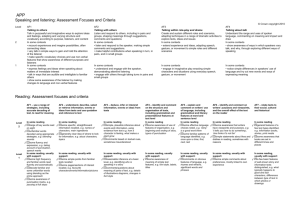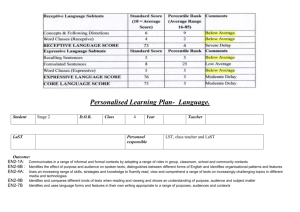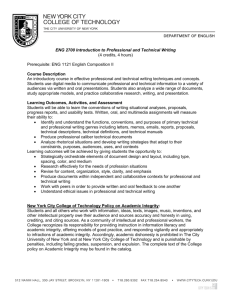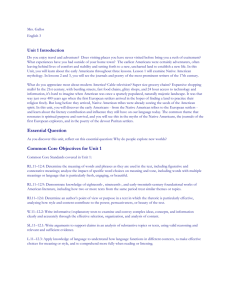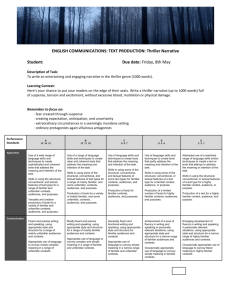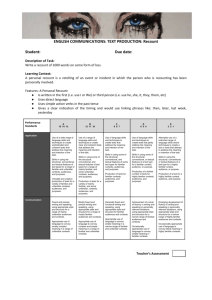Student 1 response (C grade)
advertisement
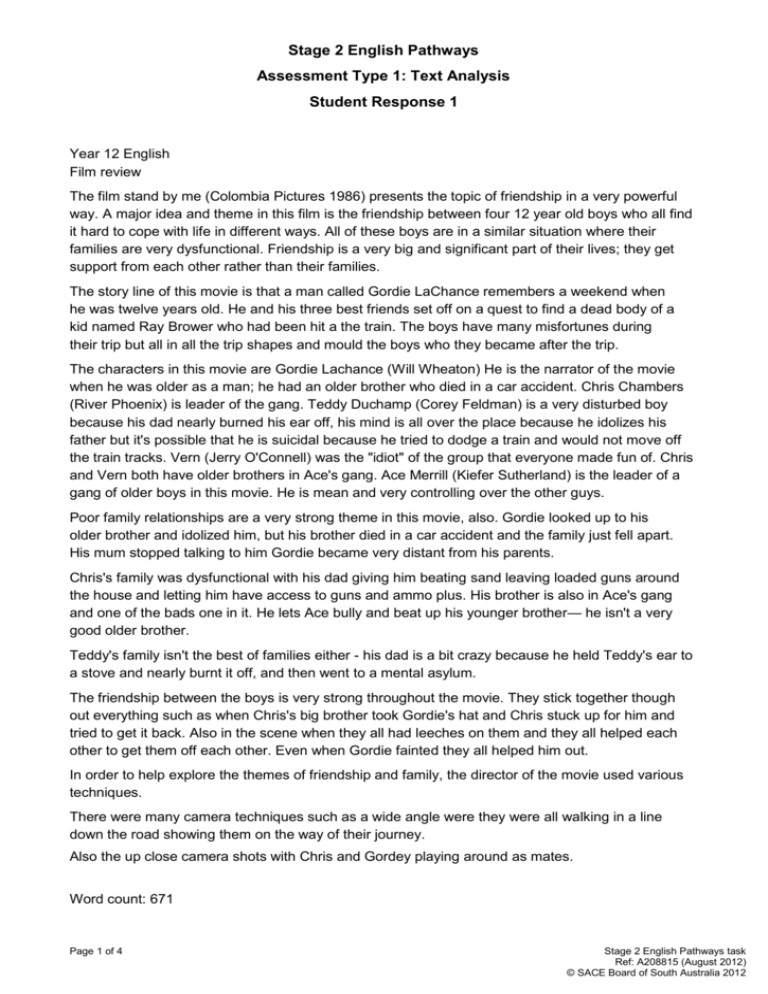
Stage 2 English Pathways Assessment Type 1: Text Analysis Student Response 1 Year 12 English Film review The film stand by me (Colombia Pictures 1986) presents the topic of friendship in a very powerful way. A major idea and theme in this film is the friendship between four 12 year old boys who all find it hard to cope with life in different ways. All of these boys are in a similar situation where their families are very dysfunctional. Friendship is a very big and significant part of their lives; they get support from each other rather than their families. The story line of this movie is that a man called Gordie LaChance remembers a weekend when he was twelve years old. He and his three best friends set off on a quest to find a dead body of a kid named Ray Brower who had been hit a the train. The boys have many misfortunes during their trip but all in all the trip shapes and mould the boys who they became after the trip. The characters in this movie are Gordie Lachance (Will Wheaton) He is the narrator of the movie when he was older as a man; he had an older brother who died in a car accident. Chris Chambers (River Phoenix) is leader of the gang. Teddy Duchamp (Corey Feldman) is a very disturbed boy because his dad nearly burned his ear off, his mind is all over the place because he idolizes his father but it's possible that he is suicidal because he tried to dodge a train and would not move off the train tracks. Vern (Jerry O'Connell) was the "idiot" of the group that everyone made fun of. Chris and Vern both have older brothers in Ace's gang. Ace Merrill (Kiefer Sutherland) is the leader of a gang of older boys in this movie. He is mean and very controlling over the other guys. Poor family relationships are a very strong theme in this movie, also. Gordie looked up to his older brother and idolized him, but his brother died in a car accident and the family just fell apart. His mum stopped talking to him Gordie became very distant from his parents. Chris's family was dysfunctional with his dad giving him beating sand leaving loaded guns around the house and letting him have access to guns and ammo plus. His brother is also in Ace's gang and one of the bads one in it. He lets Ace bully and beat up his younger brother— he isn't a very good older brother. Teddy's family isn't the best of families either - his dad is a bit crazy because he held Teddy's ear to a stove and nearly burnt it off, and then went to a mental asylum. The friendship between the boys is very strong throughout the movie. They stick together though out everything such as when Chris's big brother took Gordie's hat and Chris stuck up for him and tried to get it back. Also in the scene when they all had leeches on them and they all helped each other to get them off each other. Even when Gordie fainted they all helped him out. In order to help explore the themes of friendship and family, the director of the movie used various techniques. There were many camera techniques such as a wide angle were they were all walking in a line down the road showing them on the way of their journey. Also the up close camera shots with Chris and Gordey playing around as mates. Word count: 671 Page 1 of 4 Stage 2 English Pathways task Ref: A208815 (August 2012) © SACE Board of South Australia 2012 This text analysis is illustrative of a C- grade. Knowledge and Understanding KU1 Knowledge and understanding of the ideas, values and beliefs explored in the texts. Response shows evidence of knowledge and understanding of some of the ideas and values explored in ‘Stand by Me’: importance of friendship in supporting the development of adolescents into adults the ways in which family relationships impact on children. The majority of the evidence is presented as description or summary; for example, each character is presented in a character outline which incorporates limited analysis. The importance of the trip in forming character is mentioned in the second paragraph; however, this is not explained or expanded on through reference to textual evidence. KU2 Knowledge and understanding of the ways in which creators and readers of texts use language techniques and conventions to make meaning. Evidence of knowledge and understanding of the language techniques used by the creator of the text is limited: ’the director of the movie used various techniques such as a wide angle were (sic) they were all walking in a line down the road….’. In addition, while there is acknowledgement that there is the use of a narrator in the movie there is not detail on the effect of the narrator to make meaning. However, given that this writing was intended to be a film review the usual language techniques used in a review are not in evidence i.e. judgments on the impact of music etc. KU3 Knowledge and understanding of the ways in which texts are composed for a range of purposes and audiences. Evidence shows knowledge and understanding of the themes the creator of the text was aiming to communicate. The text does not indicate an understanding of writing the text in the form of a review to meet the expectations of the imagined reader. Analysis A2 Analysis of the ways in which language techniques are used to influence opinions and decisions in texts. A3 Analysis of the cultural, social, and technical roles of language that support effective interactions in different contexts. There is reference to the role of a camera shot showing the boys walking down the road; however, there is no analysis of the ways this influences the opinions or response of the audience. The evidence does not indicate an understanding of the intended audience for the review, which may, or may not be, the same as the film. Communication C1 C2 Accuracy, clarity, and fluency of written and spoken expression, using an appropriate style and structure. The use of language to convey meaning in a range of contexts. The writing is generally clear and mostly accurate. The structure of the film review has not been fully reproduced in the writing. Paragraphing was sound for the majority of the piece; however, paragraphs tended to be too short towards the end of the piece. Page 2 of 4 Stage 2 English Pathways task Ref: A208815 (August 2012) © SACE Board of South Australia 2012 Performance Standards for Stage 2 English Pathways A Knowledge and Understanding Analysis Application Communication Detailed knowledge and understanding of the ideas, values, and beliefs in familiar and unfamiliar texts. Detailed analysis of complex connections between personal experiences, ideas, values, and beliefs, and those explored in familiar and unfamiliar texts. Use of a comprehensive range of language skills to interact effectively in different contexts, and to analyse and solve simple and complex problems. Fluent and precise writing and speaking, using an appropriate style and structure for a range of mainly unfamiliar audiences and contexts. Perceptive analysis of a range of ways in which authors use language techniques to influence opinions and decisions in familiar and unfamiliar texts. Location, recording, analysis, and synthesis of knowledge relevant to familiar and unfamiliar contexts. Knowledge and understanding of the ways in which the creators and readers of familiar and unfamiliar texts use a range of language techniques to make meaning. Comprehensive knowledge and understanding of the ways in which familiar and unfamiliar texts are composed for a range of purposes and audiences. B Sound knowledge and understanding of some ideas, values, and beliefs in familiar, and some unfamiliar, texts. Knowledge and understanding of the ways in which the creators and readers of mainly familiar texts use some language techniques to make meaning. Sound knowledge and understanding of the ways in which mainly familiar texts are composed for some purposes and audiences. Page 3 of 4 Perceptive analysis of aspects of familiar and unfamiliar cultural, social, and technical roles of language that support effective interactions in different contexts. Analysis of some complex connections between personal experiences, ideas, values, and beliefs, and those explored in familiar, and some unfamiliar, texts. Well-considered analysis of a range of ways in which authors use language techniques to influence opinions and decisions in familiar, and some unfamiliar, texts. Well-considered analysis of aspects of mainly familiar, and some unfamiliar, cultural, social, or technical roles of language that support effective interactions in different contexts. Appropriate use of language to convey mostly complex meaning in a range of familiar and unfamiliar contexts. Sophisticated skills in reproducing the structural, conventional, and textual features of text types for a range of familiar and unfamiliar contexts, audiences, and purposes. Use of a sound range of language skills to interact effectively in different contexts, and to solve simple and complex problems. Mostly fluent and precise writing and speaking, using an appropriate style and structure for a range of mostly familiar audiences and contexts. Location, recording, analysis, and occasional synthesis of knowledge relevant to mostly familiar contexts. Appropriate use of language to convey complex and simple meaning in a range of familiar, and some unfamiliar, contexts. Sound skills in reproducing some of the structural, conventional, and textual features of text types for a range of mainly familiar, and some unfamiliar, contexts, audiences, and purposes. Stage 2 English Pathways task Ref: A208815 (August 2012) © SACE Board of South Australia 2012 C Knowledge and Understanding Analysis Application Communication Knowledge and understanding of some ideas, values, or beliefs in familiar texts. Competent analysis of simple connections between personal experiences, ideas, values, or beliefs, and those explored in familiar texts. Use of competent language skills to interact effectively in different contexts, and to solve routine problems in familiar contexts. Generally clear and accurate writing and speaking, using an appropriate style and structure for familiar audiences and contexts. Descriptive analysis of a number of ways in which authors use language techniques to influence opinions and decisions in familiar texts. Location, recording, and occasional analysis of knowledge relevant to a familiar context. Appropriate use of language to convey simple meaning in a narrow range of familiar and unfamiliar contexts. Knowledge and understanding of the ways in which the creators and readers of a narrow range of familiar texts use some language techniques to make meaning. Knowledge and understanding of the ways in which familiar texts are composed for familiar purposes and audiences. D Identification of some simple ideas, values, or beliefs in some familiar texts. Knowledge and understanding of the ways in which the creators and readers of a narrow range of familiar texts use a restricted range of language techniques to make simple or factual meaning. Knowledge of the ways in which familiar texts are composed for personally relevant purposes and familiar audiences. E Identification of a simple idea, value, or belief in a familiar text. Some knowledge and emerging understanding of the way in which a creator or reader of a highly familiar text uses a language technique to make factual meaning. Some knowledge of the ways in which highly familiar texts are composed for personally relevant purposes and highly familiar audiences. Page 4 of 4 Competent analysis of some aspects of mainly familiar cultural, social, or technical roles of language that support effective interactions in different contexts. Reference to simple connections between uncomplicated personal experiences, ideas, values, or beliefs, and those explored in familiar texts. Reference to some ways in which authors use language techniques to influence opinions and decisions in familiar texts. Reference to some simple aspects of familiar cultural, social, or technical roles of language that support effective interactions in one or more contexts. Recognition of a simple connection between a straightforward personal experience, idea, value, or belief, and that explored in a highly familiar text. Reference to the way in which an author uses language techniques to influence opinions and decisions in a highly familiar text. Recognition of some simple aspects of highly familiar cultural, social, or technical roles of language that support effective interactions in one or more contexts. Skills in reproducing some of the structural, conventional, and textual features of some text types for familiar contexts, audiences, and purposes. Use of a restricted range of language skills to interact in familiar contexts, and to solve simple problems. Location and recording of factual knowledge relevant to a familiar context. Limited skills in reproducing some of the structural, conventional, or textual features of a text type for a familiar context, audience, or purpose. Use of a restricted range of language skills to interact in highly familiar contexts, and to solve simple problems. Location or recording of factual knowledge relevant to a highly familiar context. Restricted skills in reproducing a limited number of structural, conventional, or textual features of a text type for a highly familiar context, audience, or purpose. A level of fluency in writing and speaking in personally relevant situations, using an appropriate style and structure for a narrow range of familiar audiences and contexts. Occasionally appropriate use of language to convey simple meaning in familiar contexts. Emerging development of fluency in writing and speaking in personally relevant situations, using an appropriate style and structure for a narrow range of highly familiar audiences and contexts. Occasionally appropriate use of language to convey literal meaning in highly familiar contexts. Stage 2 English Pathways task Ref: A208815 (August 2012) © SACE Board of South Australia 2012

